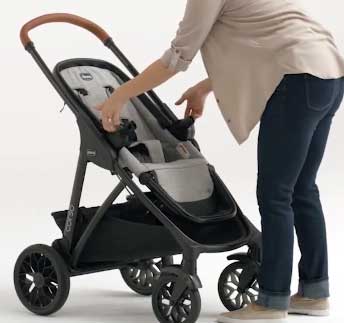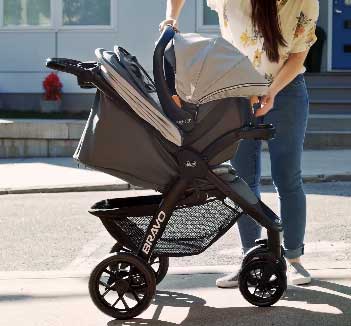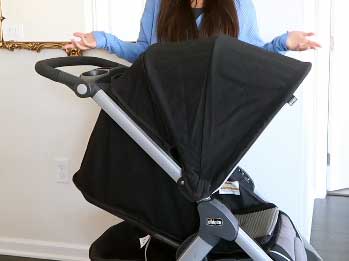As a new parent, I spent countless hours researching strollers, determined to find the perfect one for my family’s lifestyle. The Chicco Corso and Bravo kept popping up, both praised for their quality and practicality.
In this article, I’ll share my firsthand experience comparing these two popular Chicco travel systems, breaking down their features, pros, and cons from an analytical perspective. My goal is to help you decide which stroller fits your needs, whether you’re navigating city streets or planning outdoor adventures. Let’s get rolling and figure out which one’s right for you!
Comparison Table
| Feature | Chicco Corso | Chicco Bravo |
| Weight | 24.8 lbs (stroller) | 24.9 lbs (stroller) |
| Fold Type | One-hand, self-standing | One-hand, self-standing |
| Seat Orientation | Parent-facing & forward-facing | Forward-facing only |
| Car Seat Compatibility | KeyFit 30/35 | KeyFit 30/35, Fit2 |
| Suspension | Rear-wheel (LE/Primo: all-wheel) | All-wheel |
| Tires | Rubber (LE/Primo), foam-filled | Foam-filled, treaded |
| Canopy | UPF-rated, extendable w/ mesh panel | UPF-rated, non-extendable |
| Weight Limit | 50 lbs | 50 lbs |
| Price (Travel System) | $639.99 (LE), $799.99 (Primo) | $429.99 (Trio), $699.99 (Primo) |
| Bassinet Option | Yes (seat converts to bassinet) | No |
My Journey with Chicco Strollers
When I first started shopping for a stroller, I felt overwhelmed by the options. Chicco stood out because of its reputation for safety and user-friendly designs.
I narrowed it down to the Corso and Bravo, both travel systems that bundle a stroller with a car seat (typically the KeyFit 30 or 35). I wanted something versatile for city walks, zoo trips, and the occasional gravel path, so I tested both in stores and pored over user reviews.
Here’s what I learned about their key features, strengths, and quirks.
Chicco Corso: A Modern, Versatile Choice
The Chicco Corso feels like it was designed for parents who want flexibility without sacrificing style. Its modular design lets you switch between configurations, making it a great pick for newborns to toddlers.
I was immediately drawn to its sleek frame and premium fabrics, which give it a high-end vibe without the hefty price tag of brands like UPPAbaby.

Key Features of the Chicco Corso
The Corso’s standout feature is its reversible seat, which can face you or the world. This was a game-changer for me during my baby’s early months when I wanted to keep an eye on her.
The seat also flattens into a bassinet position without needing a separate attachment, perfect for naps on the go. The stroller pairs with the KeyFit 30 or 35 car seat, clicking in securely without an adapter.
The Corso’s canopy is another highlight. It’s UPF-rated, extendable, and has a mesh panel for ventilation, which kept my little one cool during summer strolls.
The large storage basket underneath held my diaper bag, snacks, and even a few grocery bags. For rougher terrain, the Corso LE and Primo models have rubber tires and enhanced suspension, which I found smoother on gravel paths than the base model’s foam-filled tires.
Pros of the Chicco Corso
- Versatile Seat Options: The parent-facing and bassinet modes make it ideal for newborns and fussy babies who want to see you.
- Smooth Ride: The LE and Primo models handle uneven surfaces well, thanks to rubber tires and all-wheel suspension.
- Stylish Design: Its sleek frame and premium fabrics look chic, appealing to fashion-conscious parents like me.
- Ample Storage: The basket is spacious and easy to access, even with the car seat attached.
- Easy to Clean: The fabrics are wipeable, and the car seat pad is machine-washable, a lifesaver after spit-up incidents.
Cons of the Chicco Corso
- Pricey: The Corso LE ($639.99) and Primo ($799.99) are significantly more expensive than the Bravo, which stung my budget.
- No Cup Holders: Neither parent nor child trays are included, so I had to buy a universal caddy separately.
- Heavy for Some: At 24.8 lbs, it’s not the lightest, especially if you’re lugging it up stairs.
- Recline Issue: Some users, including me, noticed the seat doesn’t sit fully upright, which annoyed my 9-month-old who wanted to sit up straight.
- Folding Quirk: The front wheels sometimes misalign when folding, making it less compact than expected.
My Experience with the Corso
Pushing the Corso around Buy Buy Baby felt effortless, even in tight aisles. Its agility shone on city sidewalks, and the bassinet mode was a hit for my newborn’s naps.
However, I grumbled about the lack of cup holders—my coffee had nowhere to go! On gravel trails, the LE model’s rubber tires made a noticeable difference, but the base model felt bumpier.
Folding it one-handed was a breeze, though I had to nudge the wheels to align properly. Overall, the Corso’s versatility won me over, but the price and minor quirks gave me pause.
Chicco Bravo: The Practical Workhorse
The Chicco Bravo is the reliable, no-fuss option that’s been a parent favorite for years. Known for its quick-fold system and compact design, it’s built for busy caregivers who need convenience without complexity.
I appreciated its straightforward approach, especially when I was juggling a baby and groceries.

Key Features of the Chicco Bravo
The Bravo’s claim to fame is its one-hand fold, which collapses the stroller into a self-standing position in seconds. It’s a lifesaver when you’re rushing to load the car.

The stroller works with KeyFit 30, 35, or Fit2 car seats, clicking in via a child tray (included in some models like the Bravo LE). The seat is forward-facing only, with a multi-position recline that’s nearly flat for naps.
The Bravo’s all-wheel suspension and treaded, foam-filled tires handle most terrains decently, though they’re not as robust as the Corso’s rubber tires.
The canopy is UPF-rated but smaller and non-extendable, which I found limiting on sunny days.
The parent tray with two cup holders and a zippered compartment was a practical touch I loved.
Pros of the Chicco Bravo
- Affordable: The Bravo Trio ($429.99) is budget-friendly compared to the Corso, making it easier on the wallet.
- Quick Fold: The one-hand fold is lightning-fast and self-stands, perfect for busy parents like me.
- Parent Tray: The included tray with cup holders and storage kept my essentials within reach.
- Compact: When folded, it’s slightly smaller than the Corso, fitting easily in my sedan’s trunk.
- Durable: The frame feels sturdy, and the fabrics held up well to daily use and spills.
Cons of the Chicco Bravo
- Forward-Facing Only: No parent-facing option, which I missed during my baby’s clingy phase.
- Basic Canopy: The non-extendable canopy offers less coverage, leaving my baby exposed on sunny days.
- Rougher Ride: It’s less smooth on bumpy paths compared to the Corso LE or Primo.
- Car Seat Attachment: The canopy can obstruct the car seat click-in, making it trickier than the Corso’s seamless setup.
- Weight: At 24.9 lbs, it’s nearly as heavy as the Corso, despite its compact reputation.
My Experience with the Bravo
The Bravo’s fold was a revelation—I could collapse it one-handed while holding my baby, a feat that felt like a superpower. In the store, it maneuvered well on smooth surfaces, but I noticed more jostling on uneven pavement.
The parent tray was a godsend for my water bottle and keys, but I wished the canopy offered more shade. The forward-facing seat was fine for my curious 6-month-old, but I longed for a parent-facing option earlier on.
The Bravo’s affordability and simplicity made it a strong contender, though it felt less polished than the Corso.
Head-to-Head Comparison
Now that I’ve walked you through my experience, let’s break down how the Corso and Bravo stack up in key areas.
Ease of Use
Both strollers shine here, but the Bravo’s fold is slightly faster and more intuitive. I could collapse it in one fluid motion, while the Corso occasionally required wheel adjustments.
However, the Corso’s car seat attachment felt smoother, with no canopy interference. The Corso’s reversible seat added versatility, but the Bravo’s parent tray gave it a practical edge for daily errands.
Maneuverability
The Corso LE and Primo models outperformed the Bravo on rough terrain, thanks to their rubber tires and enhanced suspension. I pushed the Corso LE over gravel trails with minimal rattling, while the Bravo felt bumpier.
For city sidewalks, both handled well, but the Corso’s smaller footprint made tight turns easier. The Bravo’s all-wheel suspension was decent but less refined.
Comfort
The Corso’s bassinet mode and parent-facing option made it comfier for newborns. Its adjustable footrest and reclining seat were plush, though the recline wasn’t upright enough for my toddler.
The Bravo’s seat was cozy with a near-flat recline, but the forward-facing-only design limited bonding time with younger babies. Both have UPF-rated canopies, but the Corso’s extendable one offered better protection.
Portability
Both strollers are similar in weight (Corso: 24.8 lbs, Bravo: 24.9 lbs), but the Bravo folds slightly smaller, fitting better in tight trunks. Neither is lightweight enough for frequent stair-climbing, which was a hassle in my walk-up apartment.
The self-standing fold on both was a win for storage in my cramped garage.
Safety
Chicco’s reputation for safety is stellar, and both strollers deliver. The KeyFit car seats (30 or 35) are top-rated, with LATCH connectors and easy installation.
The strollers’ 5-point harnesses kept my baby secure, and their sturdy frames passed rigorous safety tests. The Corso’s KeyFit 35 has an anti-rebound bar for extra stability, a slight edge over the Bravo’s KeyFit 30.
Price and Value
The Bravo Trio ($429.99) is the clear budget pick, offering solid features for the price. The Corso LE ($639.99) and Primo ($799.99) feel like premium investments, justified by their versatility and smoother ride.
If you’re on a tight budget, the Bravo delivers great value. For those willing to splurge, the Corso’s extra features are worth it for long-term use.
Which Fits Your Lifestyle?
I found the Corso ideal for urban parents or those who want a stroller that grows with their child. Its bassinet and parent-facing options are perfect for newborns, and the LE/Primo models handle outdoor adventures well.
The Bravo suits budget-conscious families who prioritize convenience and don’t mind a forward-facing seat. It’s great for quick errands and smooth surfaces but less versatile for varied terrains.
Real-World Scenarios
To help you visualize, here’s how each stroller performed in my daily life:
- City Walks: The Corso’s agility and sleek design made navigating crowded sidewalks a breeze. The Bravo was solid but felt bulkier in tight spaces.
- Zoo Trips: The Corso LE’s rubber tires smoothed out gravel paths, and the bassinet kept my newborn comfy. The Bravo handled paved areas well but rattled on uneven trails.
- Grocery Runs: The Bravo’s parent tray and quick fold were lifesavers for quick stops. The Corso’s larger basket held more, but I missed the tray.
- Travel: Both folded compactly for car trips, but the Bravo’s smaller fold was easier to Tetris into my trunk. Neither is FAA-approved for flights, so I used an umbrella stroller for air travel.
What Other Parents Say
I scoured Reddit and parenting forums to see what others thought. Many Corso users raved about the bassinet and reversible seat, though some echoed my gripe about the recline angle.
Bravo owners loved the quick fold and affordability but wished for a parent-facing option. Both got high marks for durability, with parents using them for multiple kids without wear.
Making My Choice
After weeks of testing, I leaned toward the Corso LE. Its versatility, smoother ride, and bassinet won me over, despite the higher price.
The Bravo’s simplicity and budget-friendly tag were tempting, but I valued the Corso’s extra features for my active lifestyle. Your choice depends on your priorities—budget and convenience (Bravo) or flexibility and style (Corso).
Read More: Philips Avent Breast Pump vs. Spectra
Frequently Asked Questions (FAQ)
The Corso has a reversible seat (parent- or forward-facing) and bassinet mode, while the Bravo is forward-facing only. The Corso’s LE/Primo models have better tires and suspension for rough terrain, but the Bravo is more affordable and has a parent tray.
No, the Chicco Bravo stroller is not FAA-approved for air travel. You’d need a gate-checked or compact stroller for flights.
Yes, at 24.9 lbs, the Bravo is fairly heavy, similar to the Corso (24.8 lbs), making it challenging for frequent stair-climbing.
Conclusion
Choosing between the Chicco Corso and Bravo was a tough call for me, but breaking down their features helped clarify what mattered most. The Corso’s versatility and smooth ride make it a fantastic choice if you’re after style and flexibility, while the Bravo’s affordability and quick fold are perfect for practical, budget-conscious parents.
I hope my experience gives you the confidence to pick the stroller that suits your family’s adventures. Whichever you choose, you’re getting a reliable Chicco system that’ll roll with you through parenthood’s ups and downs!
